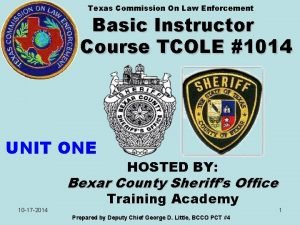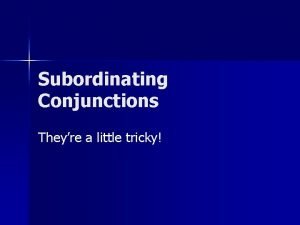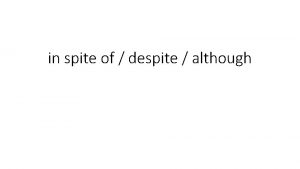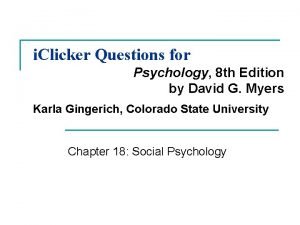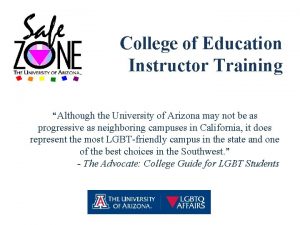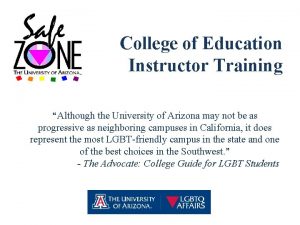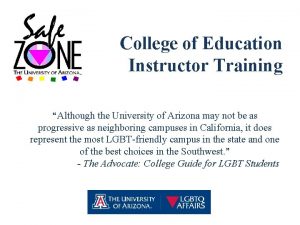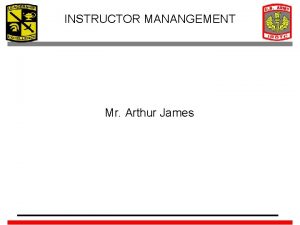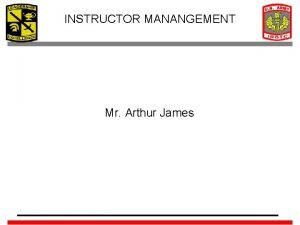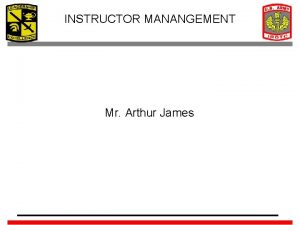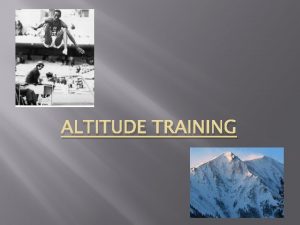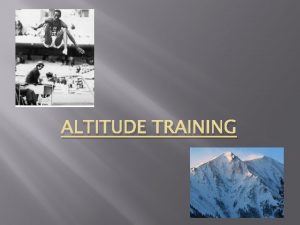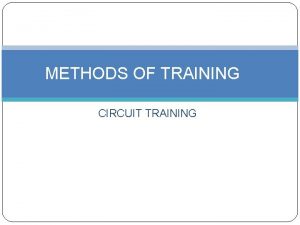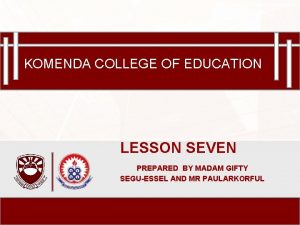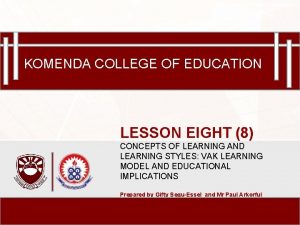College of Education Instructor Training Although the University











































- Slides: 43

College of Education Instructor Training “Although the University of Arizona may not be as progressive as neighboring campuses in California, it does represent the most LGBT-friendly campus in the state and one of the best choices in the Southwest. ” - The Advocate: College Guide for LGBT Students

Pronoun Round He/Him/His Pronouns She/Hers Pronouns They/Them/Their Pronouns


It’s Elementary—Talking about Gay Issues in Schools All kids are affected by LGBTQ prejudice, and all adults have the ability and responsibility to address it. http: //www. youtube. com/watch? v =PWyj_Of. Qpn. U

Welcoming Schools • http: //www. welcomingschools. org/ourfilms/what-can-we-do/ • http: //www. welcomingschools. org/ourfilms/what-do-you-know/

The mission for the Office of Lesbian, Gay, Bisexual, Transgender, Questioning (LGBTQ) Affairs is to build, sustain and strengthen a safe, inclusive, and open environment for faculty, staff, appointed professionals, students, alumni, parents, and guests of all gender identities and sexual orientations.

LGBTQ Resource Center


A hub for LGBTQ Work on Campus


Pride Alliance Intern Team – Fall 2014


Next training: Visit website for most up to date information. Register online at UA LGBTQ Affairs website (lgbtq. arizona. edu) • Campus-wide program committed to making UA a safer, more welcoming, and inclusive environment for LGBTQ people • The complete Safe Zone training consists of two sessions, including a General Education and an Ally Development workshop • Participants receive a Safe Zone placard to display indicating support and nurturance for LGBTQ students, staff, and faculty on our campus • We also provide speakers, panels, and lecturers upon request!

Impact of Safe Zone Program I have a Safe Zone placard on my wall, and in my position working and mentoring students I have had clear and open communication with LGBTQ students regarding their personal struggles and relationships. I think the placard was the key that let the students know they could open up to me about all of the challenges they were facing in their lives. -UA Staff, from Impact of Safe Zone Survey, spring 2011 I consider the UA Safe Zone workshops to be the best, most directly applicable workshops I have ever attended on the UA campus. LGBTQ leadership is outstanding here at the U, and a source of great pride for me and many of my classmates. -UA Student, from Impact of Safe Zone Survey, spring 2011

What are LGBTQ Students experiencing? LGBTQ students face challenges both in k 12 educational settings and in colleges. Personal challenges include facing verbal and/or physical harassment, financial problems, lack of peer or mentorship groups, and more.

Hostile School Climates GLSEN’s 2013 School Climate Survey found: • LGBT students felt unsafe because of their sexual orientation (55. 5%) and their gender identity (37. 8%) • Additionally, 74. 1% of LGBT students reported being verbally harassed, and 36. 2% reported being physically harassed (pushed or shoved) • 16. 5% reported being physically assaulted (injured) at school in the past year. GLSEN has also released state-level data and found that 95% of Arizona respondents regularly heard “gay” used in a negative way, and only 16% were taught positive representations of LGBT people, history, and events. • Over the last decade and a half, more than one person a month on average has been reported to have been killed in the U. S. because of their perceived gender identity. • Gay, lesbian, and bisexual youth are 4 times more likely to attempt suicide. Transgender youth are 9 times more likely to attempt suicide.

Chilly Climates in Higher Education Settings Campus Pride’s 2010 State of Higher Education for Lesbian, Gay, Bisexual & Transgender People reveals a “chilly” campus climate for LGBTQ students staff and faculty nationwide: • One quarter (23%) of LGBQ staff, faculty, and students reported experiencing harassment. • More than half of all faculty, students, & staff hide their sexual identity (43%) or gender identity (63%) to avoid intimidation. • More than a third of all transgender students, faculty, & staff (43%) and 13% of LGBQ respondents feared for their physical safety.

UA LGBTQ+ Needs Assessment Survey One quarter (25%) of LGBTQ+ students seriously considered suicide, 3 x more than their cisgender/heterosexual peers. 3 x more trans students felt unsafe on campus than their LGBQ+ peers. Of those, gender questioning students felt the least safe with 0% saying they felt “very safe” on campus. LGBTQ Students are diagnosed with anxiety/depression 2 x more frequently than their cisgender/heterosexual peers.

Positive Interventions: ü Empathy, empathy ü Teacher intervention üSchool policies üShifting school climate (classroom discussions, visible support for LGBTQ people)

What Teachers can Do • Intervene when they hear bias-related comments and slurs. Use each comment as an opportunity to provide education and reaffirm school policy. • Request training on preventing harassment and discrimination • Set the climate in their classrooms early and as often as necessary • Treat all forms of bias-related harassment and slurs as serious and preventable • Find out about community resources and information • Integrate representations of LGBTQ people into existing curricula.

What Schools Can Do 1. Establish and publicize a harassment policy that specifically includes sexual orientation and gender, including gender identity, appearance, and behavior 2. Train teachers and staff to intervene 3. Support the establishment of a Gay-Straight Alliance (GSA) or similar student club 4. Ensure that students know where to go for information and support 5. Introduce curriculum that includes LGBTQ people and information

We All have a Part to Play in Creating Safe Schools • Curriculum infusion is essential to get students talking and learning about LGBTQ identities. This helps them see LGBTQ people as human beings and not a minority groups that should be bullied • Family can not buffer discrimination entirely. Students need peer groups and environments that are supportive and nurturing. We can not assume that all families are accepting or safe.

• As Hermann-Wilmarth and Ryan argue, “The focus of these conversations is the consideration that all children—not only those in LGBT (lesbian, gay, bisexual, transgender) families and those who may, now or later, identify as LGBT, but all children—leave school understanding that there are multiple ways to create family, to fall in love, and to express oneself in the world” (2013, p. 226).

Children With Same-sex Parents Are A Racially, Culturally, And Geographically Diverse Group § Households headed by same-sex couples are reported in virtually every U. S. county according to the U. S. Census. § In rural states, such as Wyoming and Alaska, and in southern states households headed by samesex couples are more likely to have children than same-sex households in other states. § Hispanic and African-American same-sex couples are about twice as likely to be raising children as white non. Hispanic same-sex couples.

Books about Diversity of Families • And Tango Makes Three by Justin Richardson and Peter Parnell, illustrated by Henry Cole • Antonio’s Card/ La Tarjeta de Antonio by Rigoberto González, illustrated by Cecilia Concepción Álvarez • ABC A Family Alphabet Book by Bobbie Combs, illustrated by Brian & Desiree Rappa • Who’s in a Family by Robert Skutch, illustrated by Laura Nienhaus • Who’s In My Family? All About Our Families Robie H. Harris, illustrated by Nadine Bernard Westcott


Two queer bilingual picture books

Additional Recommended Texts with Queer Protagonists • • Marisol Mc. Donald Doesn’t Match (2011) My Princess Boy (2009) The Boy Who Cried Fabulous (2004) Morris Micklewhite and the Tangerine Dress (2014)

“Feeling an affinity for the hot pink sky helped give me a sense of self and belonging that I carried with me into adulthood and my coming out” (Gonzalez, 2015).



Scenarios: What Will you Do?

Scenario 1 A lesbian student teacher seeks your advice about what to say to her students who keep asking her if she has a boyfriend or a girlfriend. What do you say?

Scenario 2 A student teacher comes to you to seek your advice, because they have a student in their class with same sex parents. What do you say?

Scenario 3 A student teacher shares with you that many kids in his class use the phrase “that’s so gay” to describe everything from crayon colors to a math problem. He is uncomfortable with this and wants to say something, but is not sure how to address it. What do you say?

Scenario 4 Jorge, a boy in the class, occasionally comes to class wearing makeup, nail polish, and feminine blouses. Xe is often mocked by peers before/after class. You have never witnessed physical harassment and do not know how the student identifies. Would you talk to this student about their gender expression or identity? If so, what would that conversation look like?

Top 5 Ways to Support LGBTQ Students & The Office of LGBTQ Affairs

Top 5 Ways You Can Support LGBTQ Students 1. Educate Yourself • Know general terms & learn about LGBTQ issues in your field • Don’t rely on students to educate you, do the work yourself • Take advantage of Safe Zone Trainings • Break down your own biases & recognize your privileges 2. Be a Visible Source of Support • Include LGBTQ themed flyers, posters and publications in your office • Display your support (Safe Zone Sign) 3. Don’t Make Assumptions • Don’t assume a student is heterosexual • Remember that you only know someone’s sexual orientation or gender identity if they tell you what it is

Top 5 Ways You Can Support LGBTQ Students 4. Be Inclusive in Language & Practice • Use gender-neutral terms (i. e. partner or significant other rather than gender specific terms like girlfriend or boyfriend) • Respect pronouns • Use LGBTQ instead of "homosexual” • Don’t let tension around sexual orientation/gender identity continue to be unaddressed because you’re not sure what to do. 5. Speak Up • Talk to your students and your colleagues • Support other allies • Confront comments that are heterosexist or gender identity biased

How you can support our office -Know you are serving LGBTQ students -Become a Safe Zone -Know our campus resources -Refer students to our office


Need more information? Interested in LGBTQ+ Research, Teaching? • Carol Brochin, Ph. D. – Department of Teaching, Learning, and Sociocultural Studies – cbrochin@email. arizona. edu

Need Advice? Need to Refer a Student? Jen Hoefle Olson, Program Director jhoefle@email. arizona. edu (520) 626 -1996 Student Union, Rm 404 -O
 詹景裕
詹景裕 Salahaddin university college of science
Salahaddin university college of science Tipos de participantes en un curso
Tipos de participantes en un curso Tcole instructor course
Tcole instructor course Basic instructor course texas
Basic instructor course texas Basic instructor course texas
Basic instructor course texas Pepperball hotshot
Pepperball hotshot Everyone selected to serve on this jury
Everyone selected to serve on this jury Instructor vs teacher
Instructor vs teacher Ospfv
Ospfv Mptc firearms instructor
Mptc firearms instructor Basic instructor course texas
Basic instructor course texas Basic instructor course texas
Basic instructor course texas Virtual instructor art
Virtual instructor art Nfpa 1403 instructor to student ratio
Nfpa 1403 instructor to student ratio Tp 12863
Tp 12863 Instructor operating station
Instructor operating station Catia instructor
Catia instructor Instructor
Instructor Ac 61-65
Ac 61-65 Tcole 1014 basic instructor course
Tcole 1014 basic instructor course Marksmanship instructor
Marksmanship instructor Nrp instructor toolkit
Nrp instructor toolkit Utp cable
Utp cable Cbrf registry
Cbrf registry Nra certified instructor logo
Nra certified instructor logo Naismith was an instructor of
Naismith was an instructor of If your instructor were to ask if you cleaned up your room
If your instructor were to ask if you cleaned up your room Tcole advanced instructor course
Tcole advanced instructor course Tcole advanced instructor course
Tcole advanced instructor course Jrotc marksmanship instructor course online
Jrotc marksmanship instructor course online 15 sec illusion
15 sec illusion Cyan medical terminology
Cyan medical terminology Basic instructor course #1014
Basic instructor course #1014 Basic instructor course #1014
Basic instructor course #1014 Delmar cengage learning instructor resources
Delmar cengage learning instructor resources Instructor office hours
Instructor office hours Although statement
Although statement Subordinate conjunction meaning
Subordinate conjunction meaning Amid this hot green glowing gloom
Amid this hot green glowing gloom Negative linking words
Negative linking words Despite although
Despite although Although frieda is typically very reserved as
Although frieda is typically very reserved as But however although even though
But however although even though

































